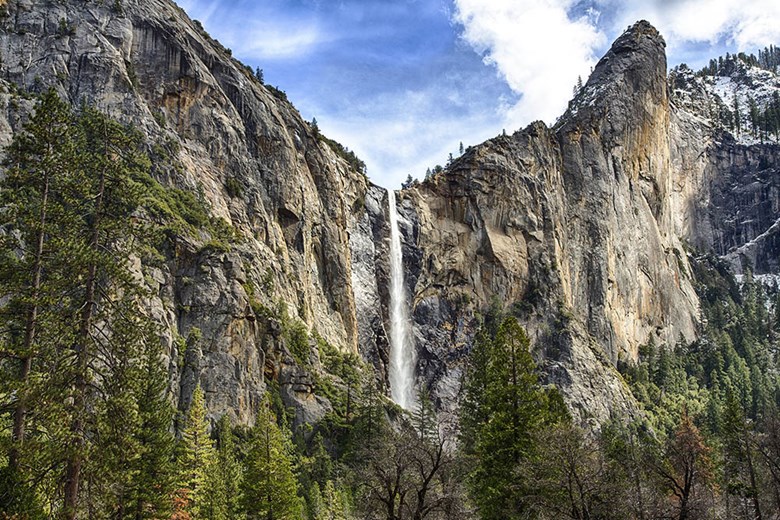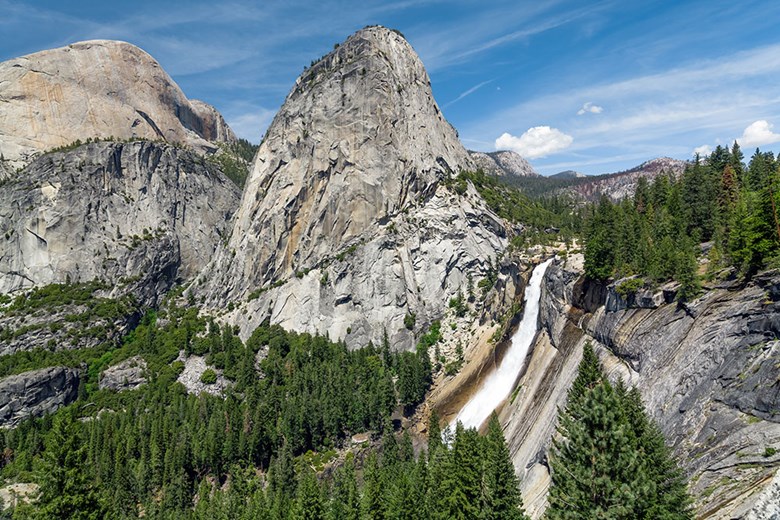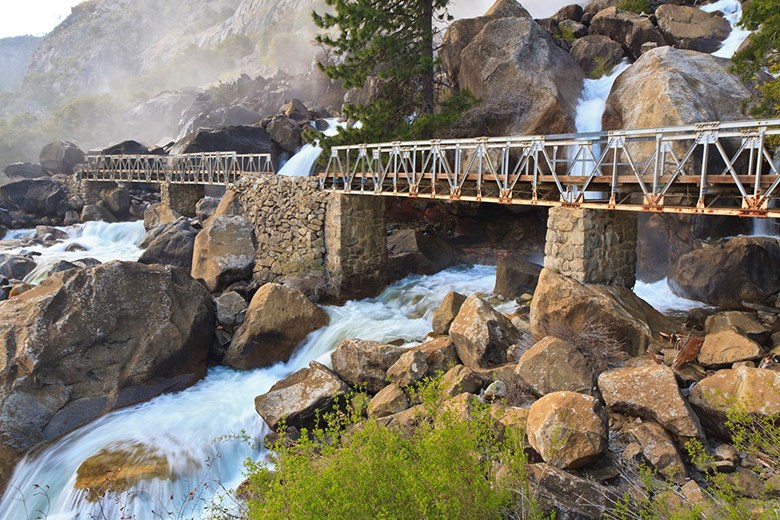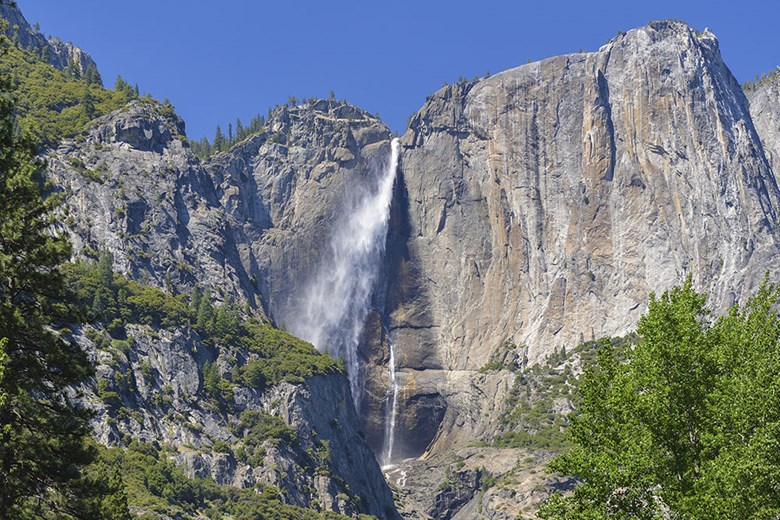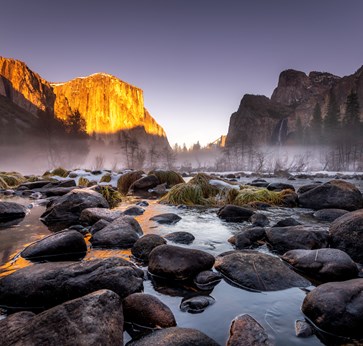The Sheer Force of Water in Motion.
Yosemite National Park is home to thousands of waterfalls—from towering spectacles with a half-mile of cascading water, to tiny streams of white that drop only a few feet. Spring is the best time to experience Yosemite’s waterfalls, when the winter’s massive snowfall melts away and heads toward the Pacific Ocean. Plan your waterfall excursions for May and June, when they’re at their most impressive. By the end of summer, many are only a trickle or have completely dried up.
WARNING: Never enter the water at the top of a waterfall! Even shallow areas have currents strong enough to sweep you over the falls. For more information on water safety, visit the National Park Service website and be sure to watch the related video.
One of the most wondrous and beautiful sights at Yosemite—and one of the rarest. For just 20 days in February, if you’re lucky enough, the Horsetail Fall’s water will be flowing, and you’ll be treated to a fiery display of reds and yellow.
Best Time to Visit Horsetail Fall
| Best Time |
Horsetail Fall offers a steady water flow December through April. The best display is in mid-to-late February when the sunset is reflected in the water's mist. |
| Best View | Park at the El Capitan picnic area (on Northside Drive, 1.7 miles west of Yosemite Valley Lodge) or in turnouts just east of the picnic area. The waterfall is visible from the road. |
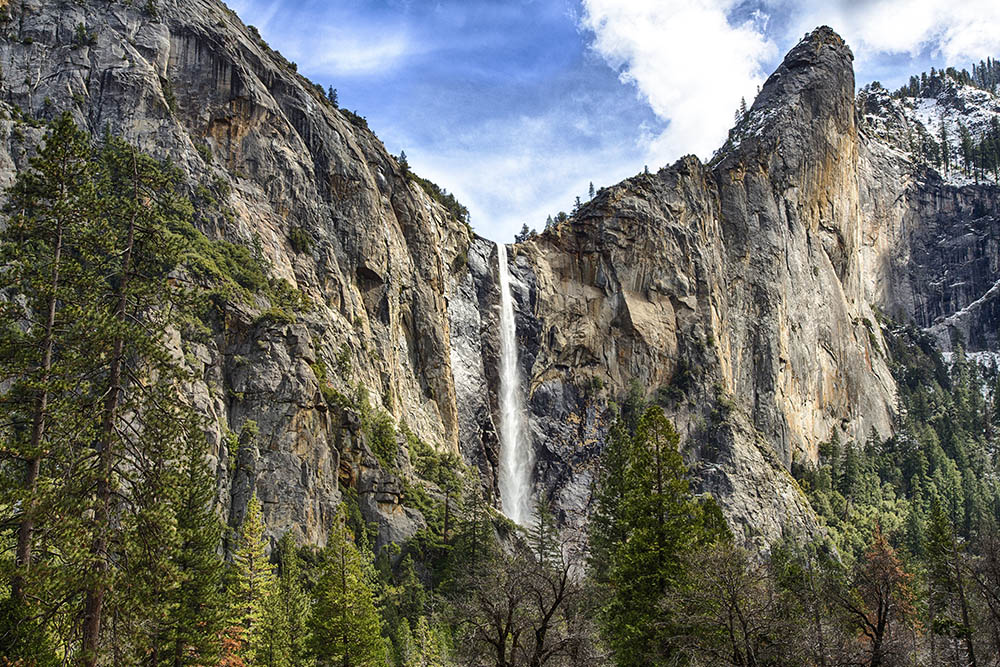
Best time to see Bridalveil Fall:
Bridalveil Fall flows all year-round and is always beautiful to see. However, like all waterfalls in Yosemite, Bridalveil Fall does experience lower water levels in late summer/early fall.
Best view of Bridalveil Fall:
You literally can’t miss Bridalveil Fall: The best view is from near the tunnels on the Wawona Road or Big Oak Flat Road and from a signed parking lot on your way into Yosemite Valley. You can walk to the base on a short but very steep (up to 24% grade) trail in under five minutes. In the spring and summer, parts of the trail can be wet. In the winter, it can become icy and slippery.
Chilnualna Falls is made of five tiers up to 300 ft in height, and makes for a fascinating display—seeing the five sections flowing separately yet together.
Best time to see Chilnualna Falls:
Chilnualna Falls flows all year-round and is always beautiful to see. However, like all waterfalls in Yosemite, Chilnualna Falls does experience lower water levels in late summer/early fall.
Best view of Chilnualna Falls:
To see Chilnualna Falls, you will need to hike the trail leading to fall. The first section of the trail is relatively easy and you will see the first tier of the fall. Strong, experienced hikers can start from the trail head at the end of Chilnualna Falls Road and climb to the top, which is steep and challenging.
While you can’t view it from the road, Illilouette Fall is hidden from view inside Illilouette Creek Canyon below Glacier Point. But those who see it say its obscurity adds to its delight.
Best time to view Illilouette Fall:
Illilouette Fall flows all year-round and is worth a visit. However, like all waterfalls in Yosemite, Illilouette Fall does experience lower water levels in late summer/early fall.
Best view of Illilouette Fall:
For the best viewing of Illilouette Fall, experienced hikers can take in the view from the Panorama Trail, which is a few miles from Glacier Point. The fall is also visible when hiking to Vernal Fall but does not provide the best vantage point. The top of Illilouette Fall is visible at Washburn Point (Glacier Point Road).
Hiking: Take the Panorama Trail from Glacier Point to Illilouette Fall (a few miles down the trail) and back to Glacier Point (strenuous). Or, from Illilouette Fall continue to Yosemite Valley (6.5 miles), but make sure you’re prepared for this roughly 6-hour strenuous hike.
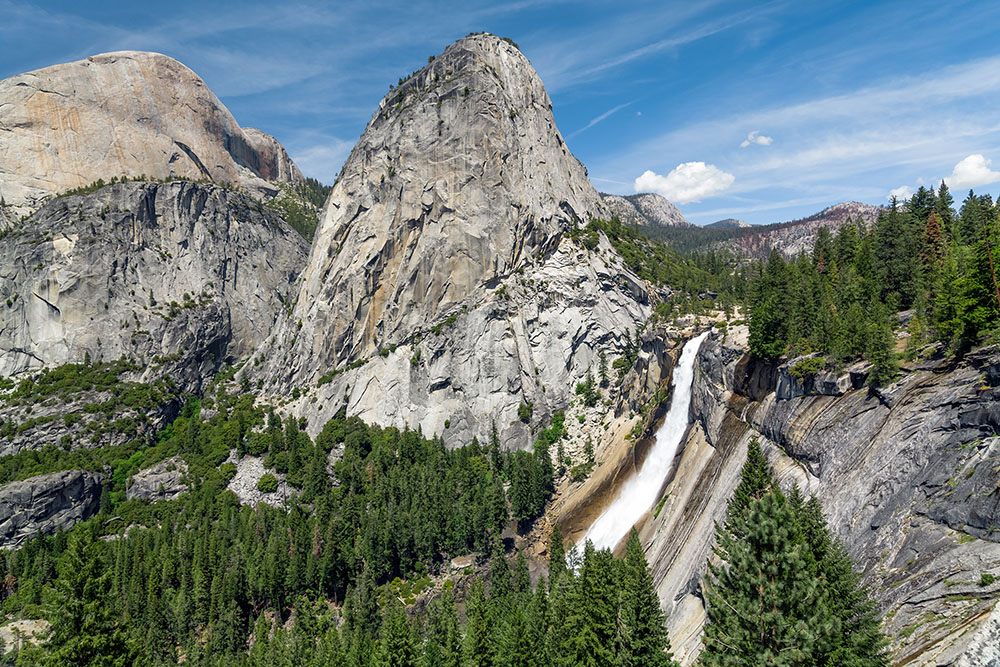
Best time to see Nevada Fall:
Nevada Fall flows all year-round and is a must see. However, like all waterfalls in Yosemite, Nevada Fall does experience lower water levels in late summer/early fall.
Best view of Nevada Fall:
By Car: Viewing from Glacier Point will give you an impressive (yet far-away) view of Nevada Fall. The road to Glacier Point is generally open from late May through November, and a wheelchair-accessible trail is available when the road is open.
Hiking: Strong, experienced hikers can reach the top of Nevada Fall by continuing along the Mist Trail (from Vernal Fall). The John Muir Trail also leads to the top of Nevada Fall (bypassing Vernal Fall). Be prepared for a strenuous hike. Note that in winter, part of the Mist and John Muir Trails are closed, but both Vernal and Nevada trails are accessible. However, the trails may be very snowy/icy.
For detailed trail information, visit the National Park Service website. And for the latest on winter trail closures, visit the PlanYourVisit page (also part of NPS website).
Ribbon Fall is the tallest waterfall in Yosemite National Park, and often only flows March through June. Not only is it the tallest fall in Yosemite, it’s the tallest waterfall in all of North America.
Best time to see Ribbon Fall:
Ribbon Fall general flows March through June. So plan your trip accordingly if you's like to see this waterfall.
Best view of Ribbon Fall:
The best view of Ribbon Fall is right from the road as you drive into Yosemite Valley, just beyond the turn for Bridalveil Fall (parking is available in turnouts).
Located on the south side of Yosemite Valley, Sentinel Fall (about 2,000 ft tall) is just west of Sentinel Rock. Like Yosemite Falls, it’s comprised of multiple cascades—smaller though no less impressive.
Best time to see Sentinel Fall:
Sentinel Fall flows March through June and is beautiful to see.
Best view of Sentinel Fall:
Viewing of Sentinel Fall is best on Southside Drive near the Sentinel Beach Picnic Area, and also near the Four Mile Trailhead. You can also see Sentinel Fall near Leidig Meadow, which is near Yosemite Valley Lodge, and while hiking Yosemite Falls Trail.
Vernal Fall’s 317-foot plunge is just downstream of Nevada Fall—both of which are visible from Glacier Point.
Best time to View Vernal Fall:
Vernal Fall flows all year-round and is beautiful to see. However, like all waterfalls in Yosemite, Vernal Fall does experience lower water levels in late summer/early fall.
Best view of Vernal Fall:
Washurn Point offers the best view of Vernal Fall. For a wide, expansive view of Vernal Fall, Glacier Point is the ideal spot. The road to Glacier Point is generally open from May through October, and a wheelchair-accessible trail is available when the road is open. Strong, experienced hikers can hike to Vernal Fall on a steep, strenuous trail.
For detailed trail information, visit the National Park Service website. And for the latest on winter trail closures, visit the PlanYourVisit page (also part of NPS website).
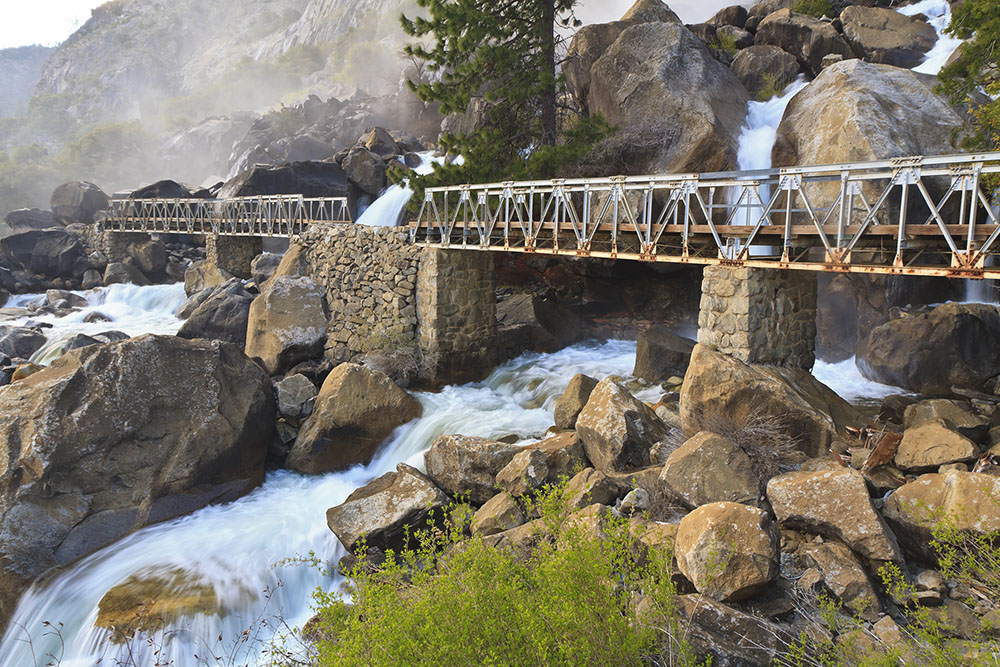
WARNING: Do NOT cross the trail bridge when Wapama Falls is flowing over the bridge. This can be very treacherous and should not be attempted.
Best time to see Wapama Falls:
Wapama Falls flows all year-round and is always beautiful to see. However, like all waterfalls in Yosemite, Wapama Falls does experience lower water levels in late summer/early fall. In recent years, there have been times when Wapama Falls completely dried up and offered no waterfall to view.
Best view of Wapama Falls:
Park at O’Shaughnessy Dam for a good view—or hike on a rough trail to near its base for a heart-pounding experience.
For details on hiking to Wapama Falls, visit the National Park Service website.
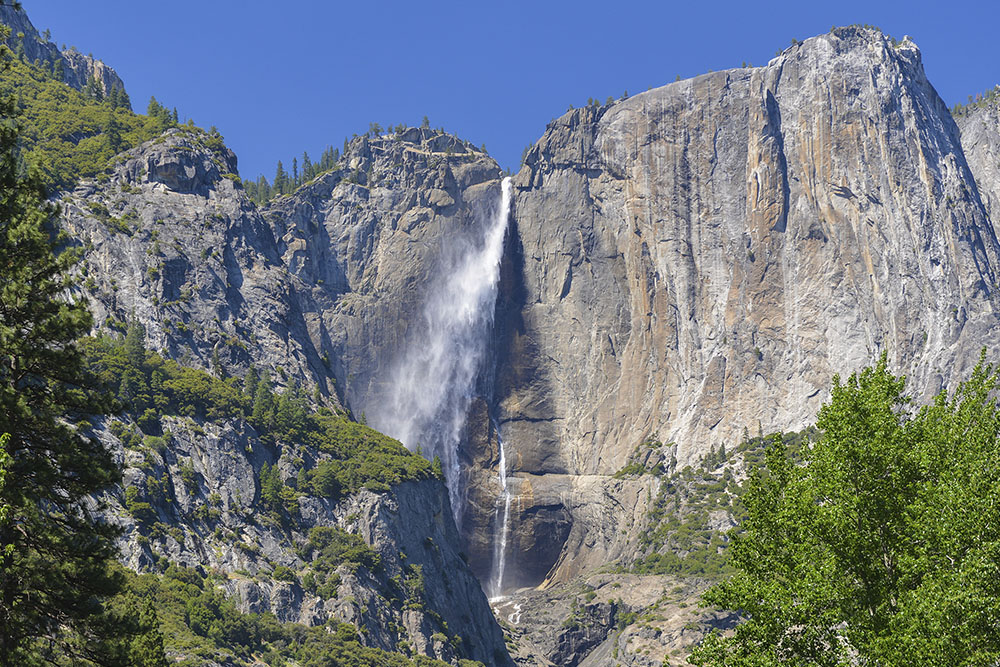
Yosemite Falls is one of the tallest in North America and fifth highest in the world—and the most famous and most photographed of Yosemite’s waterfalls. Its three separate falls drop a total of 2,425 feet—nearly half a mile. Known for its colorful rainbow in the spring, it’s one of the icons of Yosemite, and has been featured in the work of famed photographers and countless calendars and books.
Best time to see Yosemite Falls:
- Peak Flow: March
- Steady Flow: March through June
- Dry: August through October
- Rainbow: A rainbow can be seen at the lower and upper falls from time to time.
- Moonbow: A moonbow is most visible May or June and is the result of light refracting off the white surface of the waterfall.
- Ice Cone: The famous "ice cone" at the base of the upper fall is visible all winter.
Best view of Yosemite Falls:
Yosemite Falls is most visible from Yosemite Village and Yosemite Valley Lodge. A mile-long loop trail leads to the base of Lower Yosemite Fall where the viewing is unmatched. In fact, you’ll be so close that you might get a little wet in the spring and early summer! (The eastern side of the loop from the shuttle stop #6 to the base of the waterfall, is wheelchair accessible). Strong, experienced hikers can also reach the top of Yosemite falls with a strenuous, all-day hike.
The National Park Service offers more details about Yosemite Falls Trail and Lower Yosemite Fall Trail to help you further plan your trip to Yosemite National Park.




